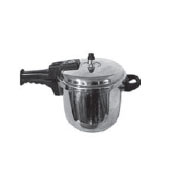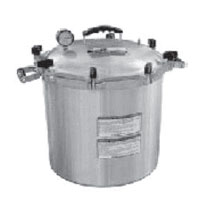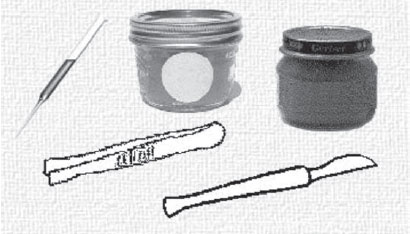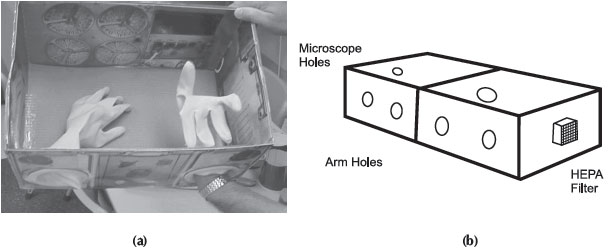Sterile Methods in Plant Tissue Culture
 |
 |
| Figure 10 Scientists and housewives use similar instruments. |
|
Using a Pressure Cooker as an Autoclave
- Check the pressure cooker seal. If stiff or damaged, do not use the pressure cooker!
- Place items on a rack inside the pressure cooker.
- Add water to a level below the rack.
- Grease the lugs with petroleum jelly.
- Close the pressure cooker, making sure that the seal is well seated.
- Place the pressure cooker on high heat.
- Begin timing when a steady stream of steam emerges from the vent.
- After 15 minutes, turn the heat off and let cool before opening the pressure cooker.
Or, follow the manufacturer’s directions for “canning” fruit and other lowacid food.
- Opening a pressure cooker while still warm is very dangerous.
- High pressure and hot steam can kill or maim.
 |
| Figure 11 |
- Place tweezers, forceps, and scalpels in a wide-mouthed jar, business end down, and cover with a doubled piece of aluminum foil. (These items can be resterilized inside the glove box by washing in bleach solution and rinsing with sterile water.)
- Wrap single-edged razor blades (if used) in aluminum foil and autoclave in the pressure cooker for 15 minutes.
- Autoclave jars covered with a doubled piece of aluminum foil. When the pressure cooker is cool enough to open, snap a rubber band around the foil immediately.
- Sterilize water in glass jars with lids on loosely. Screw the lids down as soon as the pressure cooker is opened.
- Place paper inside a paper bag and autoclave in the pressure cooker above the water level. After sterilization, dry the bag in an oven set at 80°C. Do not unwrap the papers until needed.
 |
| Figure 12 |
These directions will work for both the inexpensive cardboard-plastic-film glove box and the more expensive plastic glove box.
- Tie back your hair, roll up your sleeves, and remove your watch and other jewelry.
- Collect and organize all the items you will need inside the cabinet.
- Close and seal the homemade glove box. (Plug in the HEPA filter fan, if used.) The active cabinet will not be tightly sealed like the passive one. (Air needs to leak out.) Note: The active cabinet will not be tightly sealed like the passive one. (Air needs to leak out.)
- Wash your hands thoroughly with the Pert (or other disinfectant).
- Put on a pair of surgical gloves.
- Insert your gloved hands through the sleeves.
- Sterilize the inside of the cabinet, including your gloved hands, by spraying with 70% alcohol and wiping dry with sterile tissue.
- Sterilize all jars and implements by spraying with 70% alcohol and wiping dry with sterile tissue.
- Discard the used tissues in a small bag or box inside the glove box.
- If using the active glove box, do the following:
- Sterilize the inside of the inner cabinet, including your gloved hands, by spraying with 70% alcohol and wiping dry with sterile tissue.
- Turn on the HEPA filter fan.
- Pass the items through the inner chamber.
Note: From this point on, do not remove your gloved hands from the glove box. If you must, close all jars first and resterilize everything before starting to work on cultures again.
Sterilizing Plant Materials
- Inside the homemade glove box, sterilize all plant material in diluted domestic bleach solution containing 1 drop of detergent as a surfactant.
- Put plant pieces in a jar containing the bleach for 10–20 minutes. Agitate frequently.
- Transfer the tissue in the bleach solution to the sterile area.
- Discard the chlorine solution.
- Rinse plant pieces twice with sterile water.




